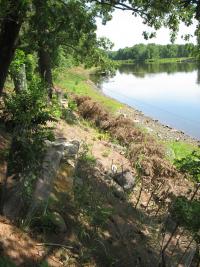What's Working for Conservation
Bioengineering
2018 Information
Cedar Revetments: The DNR Division of Waters completed a performance audit of Tree Revetment Stream Bank Protection in Region V. The audit took place during the summer of 1996 during the months of June and July by Division of Waters intern, Mark Packard.
A tree revetment is form of Bio-engineering used to prevent shore line erosion and to restore existing eroding banks. It is a beneficial form of erosion remediation because of its low cost and ease of accessing materials. Tree revetments do or have the potential to work very well to stabilize banks.
A tree revetment is made up of cedar trees which are used for their extensive branch system and their resistance to rotting. The cedars are anchored to the toe of an eroding bank approximately half way into the stream at ordinary water level. The cedars are connected to one another by aircraft cable and clamps, with each tree bottom attached to the top of another and so on. Each top and bottom of each tree is also attached to steal posts or anchors, also with aircraft cable, which are in turn driven into the toe of the bank. This chain of trees is positioned so that the butt of the trees faces up stream so as to trap sediment that is entrained in the water. Many times the bank is also planted with native shoreline grasses and sometimes willow stakes to help to hold the bank together with their extensive root systems.
In general, submerging the cedars half way into the water at ordinary water level on the toe of the slope seems to be important in that it provides more branch surface area for the sediment to accumulate, as intended. Shaping the slope above the cedars also seems to be an important factor in how fast the bank stabilizes, especially in cases where flood or high water episodes have not been present to deposit sediment. Shaping involves the movement of the soil at the top of the slope to the bottom partially on top of the cedars but not into the stream. This both removes the potential for the collapsing of a steep bank (a 2:1 slope is ideal), and it partially fills in the framework that the cedar provides so that plant life can ultimately take hold.
There should also be an effort to revet up and down stream of the problem area until the end cedars can be anchored to a solid shore line. Some sites may have benefited from a second row of cedars above the first. This second row would not necessarily be submerged but could be filled in with collapsed material and could serve to trap sediment during flood stages after the bottom row of cedars have been filled. They would also serve to slow the velocity of the stream, effectively lessening the blow to the bank.
The more time and care that was taken throughout the planning and installation phases, was observed to be directly proportional to the overall project results. Land owners reported that project managers who really cared and were involved in the construction and maintenance usually had the most success with their tree revetments.

